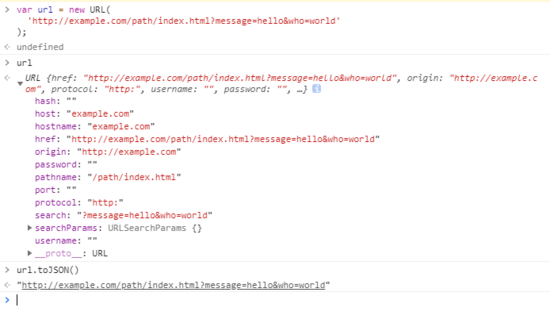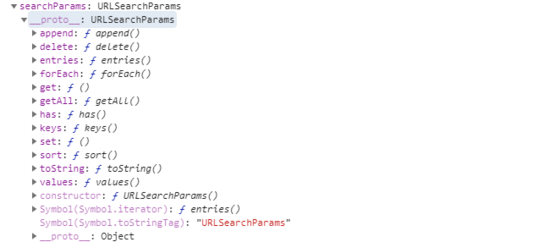JavaScript URL构造函数 浅谈JavaScript中你可能不知道URL构造函数的属性
vipbic 人气:0URL
URL 是统一资源定位符,对可以从互联网上得到的资源的位置和访问方法的一种简洁的表示,是互联网上标准资源的地址。互联网上的每个文件都有一个唯一的 URL,它包含的信息指出文件的位置以及浏览器应该怎么处理它,
在 Web 开发中,有许多情况需要解析 URL,这篇主要学习如何使用 URL 对象实现这一点
例如,这里是这篇博客文章的路径:
https://www.vipbic.com/thread.html?id=101
通常您需要访问 URL 的特定属性。这些可能是主机名(例如 vipbic.com ) ,或者路径名(例如/thread)
JavaScript用于访问URL对象的提供一个URL()构造函数,很方便解析
一个完整URL
用一张图片来解释,没有太多的文字描述,在下面的图片中你可以找到一个 URL 的主要包含属性:

URL constructor
URL ()是一个 constuctor 函数,它可以解析 URL 的对象:
const url = new URL(relativeOrAbsolute [, absoluteBase]);
relativeOrAbsolute参数可以是绝对 URL,也可以是相对 URL。如果第一个参数是相对的,那么第二个参数 absoluteBase 必须是绝对 URL,它必须是第一个参数的基础
例如,让我们用一个绝对 URL 初始化 URL():
const url = new URL('http://example.com/path/index.html');
url.href; // => 'http://example.com/path/index.html'
或者合并相对和绝对的 url:
const url = new URL('/path/index.html', 'http://example.com');
url.href; // => 'http://example.com/path/index.html'
创建 URL ()实例后,可以访问实例:
interface URL {
href: USVString;
protocol: USVString;
username: USVString;
password: USVString;
host: USVString;
hostname: USVString;
port: USVString;
pathname: USVString;
search: USVString;
hash: USVString;
readonly origin: USVString;
readonly searchParams: URLSearchParams;
toJSON(): USVString;
}
可以尝试在浏览中打印

Query string
Search 属性访问前缀为? : 的 URL 的查询字符串:
const url = new URL( 'http://example.com/path/index.html?message=hello&who=world' ); url.search; // => '?message=hello&who=world'
如果查询字符串不存在的字符串,url.search 将返回为空字符串” :
const url1 = new URL('http://example.com/path/index.html');
const url2 = new URL('http://example.com/path/index.html?');
url1.search; // => ''
url2.search; // => ''
Parsing query string

访问查询参数比访问原始查询字符串更方便
一种简单的查询参数选择方法提供了 url.searchParams 属性,该属性包含 URLSearchParams 的实例
URLSearchParams 对象提供了许多方法(如 get (param)、 has (param))来访问查询字符串参数
看一个例子:
const url = new URL(
'http://example.com/path/index.html?message=hello&who=world'
);
url.searchParams.get('message'); // => 'hello'
url.searchParams.get('missing'); // => null
get.('message'),返回消息查询参数的值-‘ hello',当去尝试,访问一个不存在的参数 url.searchParams.get('missing')的结果为 null
hostname
Hostname 属性包含 URL 的主机名:
const url = new URL('http://example.com/path/index.html');
url.hostname; // => 'example.com'
pathname
属性获取 URL 的路径名:
const url = new URL('http://example.com/path/index.html?param=value');
url.pathname; // => '/path/index.html'
如果 URL 没有路径,URL.pathname 属性将返回斜杠字符/:
const url = new URL('http://example.com/');
url.pathname; // => '/'
hash
可以使用 url.hash 属性访问#后面的参数:
const url = new URL('http://example.com/path/index.html#bottom');
url.hash; // => '#bottom'
当 URL 中的散列#时,URL.hash 计算为空字符串” :
const url = new URL('http://example.com/path/index.html');
url.hash; // => ''
URL validation
当new URL ()构造函数创建一个实例时,作为副作用,它还验证 URL 的正确性。如果 URL 值无效,则抛出 TypeError
例如,http ://example. com 是一个无效的 URL,因为 http 后面的空格字符
让我们使用这个无效的 URL 来初始化解析器:
try {
const url = new URL('http ://example.com');
} catch (error) {
error; // => TypeError, "Failed to construct URL: Invalid URL"
}
因为'http ://example. com'是一个无效的 URL,正如预期的那样,new URL ('http ://example. com')抛出一个 TypeError
URL manipulation
除了访问 URL 属性之外,搜索、主机名、路径名、hash等属性都是可写的ーー因此您可以操作 URL
例如,让我们把现有 URL 的主机名从 red. com 修改为 blue.io:
const url = new URL('http://red.com/path/index.html');
url.href; // => 'http://red.com/path/index.html'
url.hostname = 'blue.io';
url.href; // => 'http://blue.io/path/index.html'
注意,只有 URL ()实例的 origin 和 searchParams 属性是只读的。其他的都是可写的,当你改变它们的时候可以修改 URL
总结
URL()构造函数可以方便地在 JavaScript 中解析(和验证) URL
new URL (relativeOrAbsolute [ ,absolute base ])接受作为第一个参数的绝对或相对 URL。如果第一个参数是相对的,则必须将第二个参数指
示为一个作为第一个参数基础的URL
创建 URL()实例后,可以获取到以下实列方法
- url.search 原始查询字符串
- url.searchParams 选择查询字符串参数
- url.hostname 访问主机名
- url.pathname 读取路径名
- url.hash #后面的参数
文章属于翻译,作者部分有所改动,
作者:羊先生
英文原文, https://dmitripavlutin.com/parse-url-javascript/
加载全部内容